What’s worse than losing a customer? Not knowing why they left, and realizing that it was too late, they’re never coming back.
Customer churn isn’t just a number—it’s a quiet problem that slowly eats away at your growth while you’re busy getting new customers. Every person who leaves is trying to tell you something: maybe your pricing didn’t work for them, a feature was missing, or something in their experience was confusing or frustrating. And if you don’t catch it in time, it adds up fast.
That’s your job-to-be-done here: not just knowing who left, but understanding why they left—and how to stop it early.
Whether you’re facing:
- Customers leaving your online store without converting,
- Users bouncing off your admin portal,
- Applicants abandoning forms midway, or
- Employees disengaging silently…
This guide gives you the tools to fix it.
You’ll get:
- The churn rate formula (with a real example).
- A step-by-step churn prediction model.
- A free churn tracking sheet.
- 12 tested strategies to reduce churn across onboarding, usage, and re-engagement.
- And some pro tips to take action.
Because retention isn’t just about saving money. It’s about learning faster, converting better, and building something people stick with.
Let’s make churn your growth advantage.
What Is Customer Churn?
Customer churn is the number of customers who walk out of the door in a given period. It includes customers who move to the competition and those who terminate services or stop purchasing products from you.
In its simplest form, churn is a signal that your product or service no longer meets a user’s expectations—or that something in the experience pushed them away.
Here’s the standard churn rate formula:
(Customers lost during a period ÷ Customers at the start of the period) × 100
We’ll walk through a worked example in the next section to help you apply this.
Customer churn, when uncontrolled, is a serious problem for a business. To give you an idea about its impact on your business, let’s crunch some numbers.
Say two companies acquire the same number of customers per year and earn an average of $2000 per customer. But the churn rate of company A is 5%, and that of company B is 15%.
Let’s see how they fare after five years:


As we can clearly see:
- In five years, company B earned over 27% less than its competitor, Company A, which equates to $576,000.
- In the fifth year, the difference between the two companies’ annual revenues was a staggering 58%.
- When we talk about the difference in customer base, company B lost twice as many customers as company A, which is not suitable for brand image.
Remember that when churn occurs among your high-value customers, the revenue gap becomes even more painful.
Pretty scary scenario indeed!
That’s why you have to understand why this happens and how to deal with it.
Why Customers Churn (And What to Watch For)
If you want to reduce unnecessary churn, you first need to spot it and find out its cause. Only then can you implement the measures to retain customers before they leave.
So, there are primarily two types of churn behavior that can stem from your end or the customer’s side.
1. Voluntary Customer Churn
Voluntary churn occurs when customers decide to terminate services on purpose. Businesses need to be alert for this type of churn, as it might be due to serious product issues or problems with their support services.
As to what causes this behavior, multiple factors can contribute to it:
1. Change in Prices: A price change can make a product unaffordable for some customers, prompting them to look for alternatives. Run a pricing analysis before changing your pricing structure. You can add a small survey on your website or app to gauge customer preference and how they perceive your current pricing tiers.
2. Business Shutdown: This one is out of control, and you cannot prevent it.
3. Unsatisfactory Services & Support: If your customers face constant product issues and their grievances are not addressed on time, they are bound to look for better shores.
4. Better Value for Money Offered by the Competition: People are always looking for better services, prices, and product value. If your competition has a better product offering, you will lose even your loyal customers in the long run. That’s why it is necessary to run a competition analysis to stay ahead in the race.
5. Change in Product Requirements or Business Model: This situation is also out of your hands. In this case, the only way to stop churn is to analyze the customer’s new requirements and see if your product solution fits their model.
Innovation is the key to increasing customer engagement and retention in today’s world. If your product is not evolving with technological advancements, you may lose your customers to competitors offering new and improved features to make work easier.
Bonus: Churn doesn’t always happen out loud. Watch for disengagement—declining logins, reduced usage, skipped upgrades—as early signals of silent churn. Don’t just react to cancellations—anticipate them. Track signals like skipped onboarding steps, low feature adoption, or no login in the last 14 days.
2. Involuntary Customer Churn
Involuntary churn occurs when customers cancel their services or subscription due to an unforeseen situation or incident. Payment issues are one of the primary reasons for involuntary churn, especially for a subscription-based pricing model.
Some of these instances include:
- Payment failures due to card declination
- Issues at checkout
- Failure to update payment information
- Loss of customer account or card
All these factors represent a loss of a customer who was willing to provide you revenue. The good news is, involuntary customer churn is easily avoidable using simple measures:
- To monitor such behavior, you can set triggers that remind customers about their upcoming payments.
- Encourage them to set up auto-payment in their account to prevent subscription cancellation.
- Deliver automatic notifications about payment failures to customers via email and SMS and remind them to update the card information to avoid service cancellation.
- Set an alert at your end whenever a service is canceled due to payment failure so you can quickly follow up and take necessary actions to prevent customer churn.
Bonus: Use exit-intent surveys or post-cancellation triggers to collect last-minute feedback—then act on it fast. A one-question ask is better than silence. If payment failures are a top churn driver, set up an automated retry system and follow-up cadence. Don’t give up after the first failed charge.
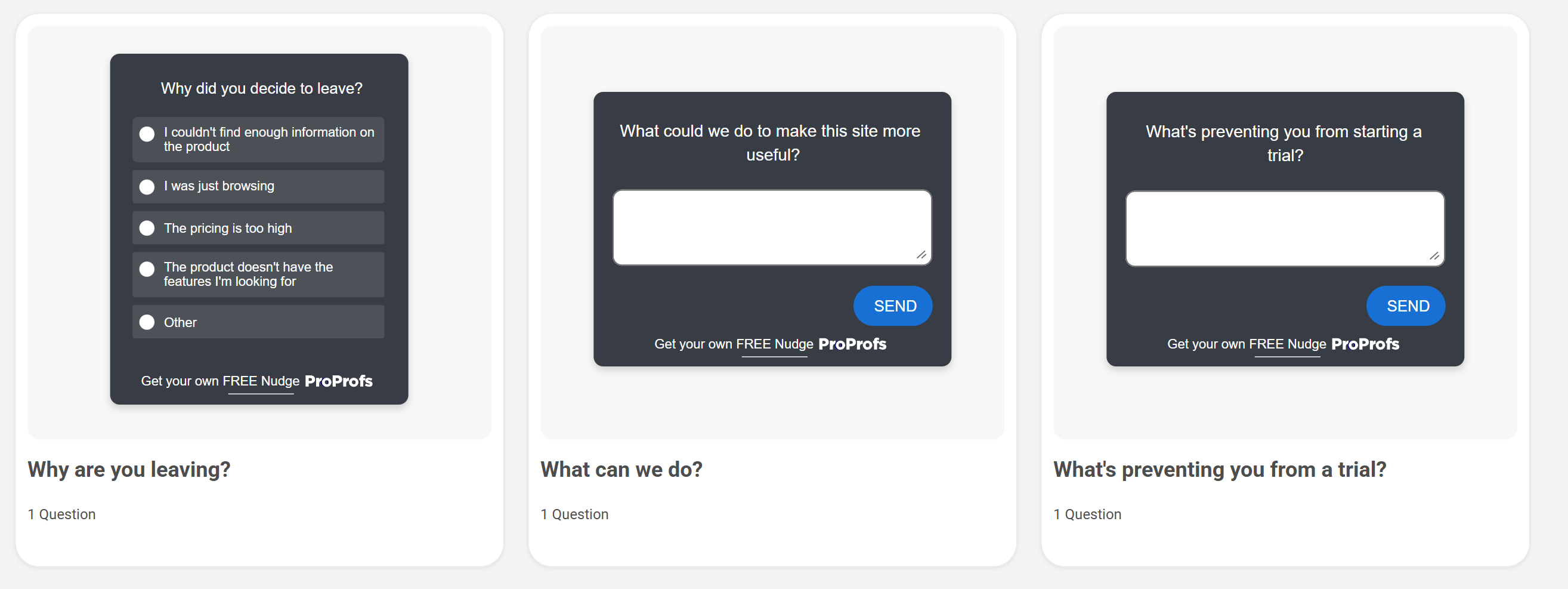
How to Calculate Churn Rate (With a Worked Example)
Understanding churn starts with knowing how to calculate it correctly. Too many teams wing this number or misinterpret it, leading to dire forecasts and worse decisions.
Let’s fix that with a simple formula and a real-world example you can model from.
The Basic Churn Rate Formula:
Customer Churn Rate = (Customers Lost During Period ÷ Customers at Start of Period) × 100
This gives you a percentage that tells you what portion of your customer base stopped doing business with you in a specific timeframe (monthly, quarterly, annually—depending on your model).
Let’s Work Through an Example:
Say you started the month with 500 customers. By the end of the month, 470 remained.
Step 1: Subtract remaining customers from starting customers: 500 – 470 = 30 customers lost
Step 2: Divide lost customers by starting count: 30 ÷ 500 = 0.06
Step 3: Convert to a percentage: 0.06 × 100 = 6% churn rate
That means your churn rate this month was 6%.
Bonus: Track churn over rolling 30-, 60-, and 90-day windows. Sudden spikes are often lagging indicators of issues that happened weeks ago (like poor onboarding or a buggy feature release).
When & Where Churn Happens in the Customer Journey
Churn doesn’t happen randomly—it follows predictable patterns across your customers’ lifecycle. Understanding these “churn hotspots” helps you apply the right intervention at the right moment.
Stage 1: Product Adoption (Help me experience early value fast)
This is the most fragile moment. Users are exploring your product and forming first impressions. Missed onboarding, unclear UI, or friction during sign-up can cause drop-off before value is delivered.
Bonus: Most early churn happens within the first 7 days. Track time-to-value (TTV) and feature activation rates to catch drop-off before it’s too late.
Stage 2: Product Usage (Help me succeed repeatedly with minimal friction)
This is where retained users live—or leave silently. Watch for declining engagement, skipped features, repeat support tickets, or unanswered questions.
Bonus: Use survey tools (like Qualaroo) inside your app or site to ask: “What’s the one thing you wish worked better here?” Small prompts lead to big retention wins.
Stage 3: Drop-Off or Switching (Keep me loyal when I’m tempted to leave)
This is where customers are weighing alternatives. If your product hasn’t evolved, pricing isn’t competitive, or their needs change, churn can spike.
Bonus: Run exit-intent surveys or post-cancellation feedback forms. One last honest answer can inform 100 product decisions.
FREE. All Features. FOREVER!
Try our Forever FREE account with all premium features!
12 Practical Strategies to Reduce Customer Churn in 2025
We’ll be diving into the most crucial part of this entire exercise – reducing customer churn. Let’s now look at some of the measures that can help you improve your churn rate at each stage:
1. Benchmark Your Numbers
Churn reduction isn’t guesswork—it’s iteration. You can’t reduce what you haven’t defined.
Start with a baseline:
- What’s your current churn rate?
- How does it compare to others in your space (SaaS, D2C, B2B)?
- What types of customers churn the most?
Then segment your churn:
- First 30 days vs. after 90 days
- By acquisition channel
- By product type or plan
Pro Tip: Most companies calculate churn once a year. Top performers track it monthly, broken down by cohort and LTV tier. Create a simple Google Sheet (or grab our free template below) to log churn by month, segment, and reason. It’s your single source of truth.
![]()
2. Leverage Churn Rate Analysis Software
You can’t fight churn with spreadsheets alone—especially at scale. To uncover patterns and act fast, you need tools that combine behavior data, segmentation & targeting, and alerts in real time.
Start with what you already have:
- Voice of Customer tools like Qualaroo let you surface in-the-moment sentiment and pain points—before it’s too late.
- CRM systems (like BIGContacts) can show login frequency, plan downgrades, and engagement drops.
- BI platforms (like Microsoft Power BI or Tableau) help you visualize churn trends and segment by channel, geography, or plan.
The key is to connect feedback with usage behavior. That’s how you move from lagging indicators to leading signals.
Pro Tip: Don’t just collect churn data—tag it by root cause. Categorizing “Why they left” across 5–6 themes makes your strategy 10x clearer. Use Qualaroo’s behavior-triggered surveys to run campaigns on pricing objections, feature confusion, or UX feedback—right at the decision moment.
Watch this short video to learn how to create in-context surveys that are triggered based on user behavior:
3. Monitor CX Metrics Like NPS, CSAT, and CES
Your customers won’t always tell you they’re unhappy. But their scores will. That’s why tracking experience metrics like NPS (Net Promoter Score), CSAT (Customer Satisfaction), and CES (Customer Effort Score) is one of the most reliable ways to predict churn early.
Here’s how each one helps:
- NPS tells you how loyal your users are (and who’s likely to churn or refer).
- CSAT tells you how happy they are with a specific interaction.
- CES reveals how hard it is for them to get something done (support, checkout, setup).
Track these over time, especially across:
- Onboarding
- Support resolution
- Product updates
- Cancellation or refund flow
Don’t stop at the score. Ask why right after. Even a 1-line response gives you context to act on.
Use a simple follow-up like:
“What’s the main reason for your score?”
Pair this with tags (pricing, usability, speed, support) to quickly analyze trends.
Pro Tip: With Qualaroo, you can trigger these micro-surveys on-page or in-app—exactly when the customer takes (or avoids) key actions.
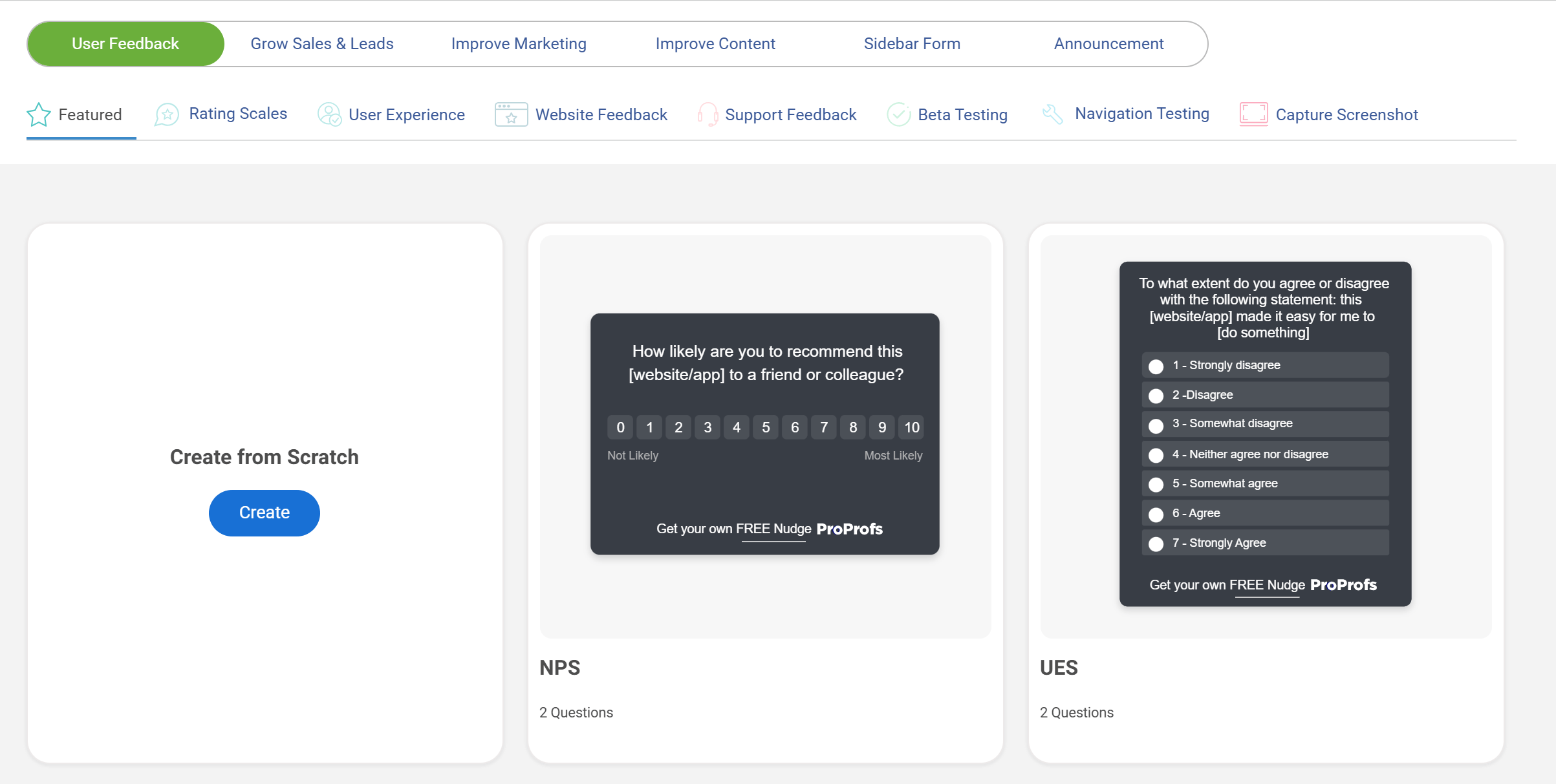
4. Personalize the Customer Experience
Churn often stems from irrelevance. When your product or communication feels generic, customers disengage—even if the product technically works.
Personalization isn’t just about using a name. It’s about recognizing behaviors, preferences, and intent—and adapting to them.
Ways to personalize effectively:
- Segment users by plan, behavior, industry, or device type.
- Recommend features based on what they’ve used (or ignored).
- Adjust onboarding flows based on role, goals, or use case.
- Send retention nudges based on drop-off signals (e.g., “Need help finishing setup?”).
Pro Tip: Not sure what to personalize?
Use Qualaroo to ask: “What were you hoping to do here today?”
This one micro-survey can reshape your product’s first impression. Run A/B tests with and without personalization. You’ll often see up to 3x increase in feature activation or repeat visits.
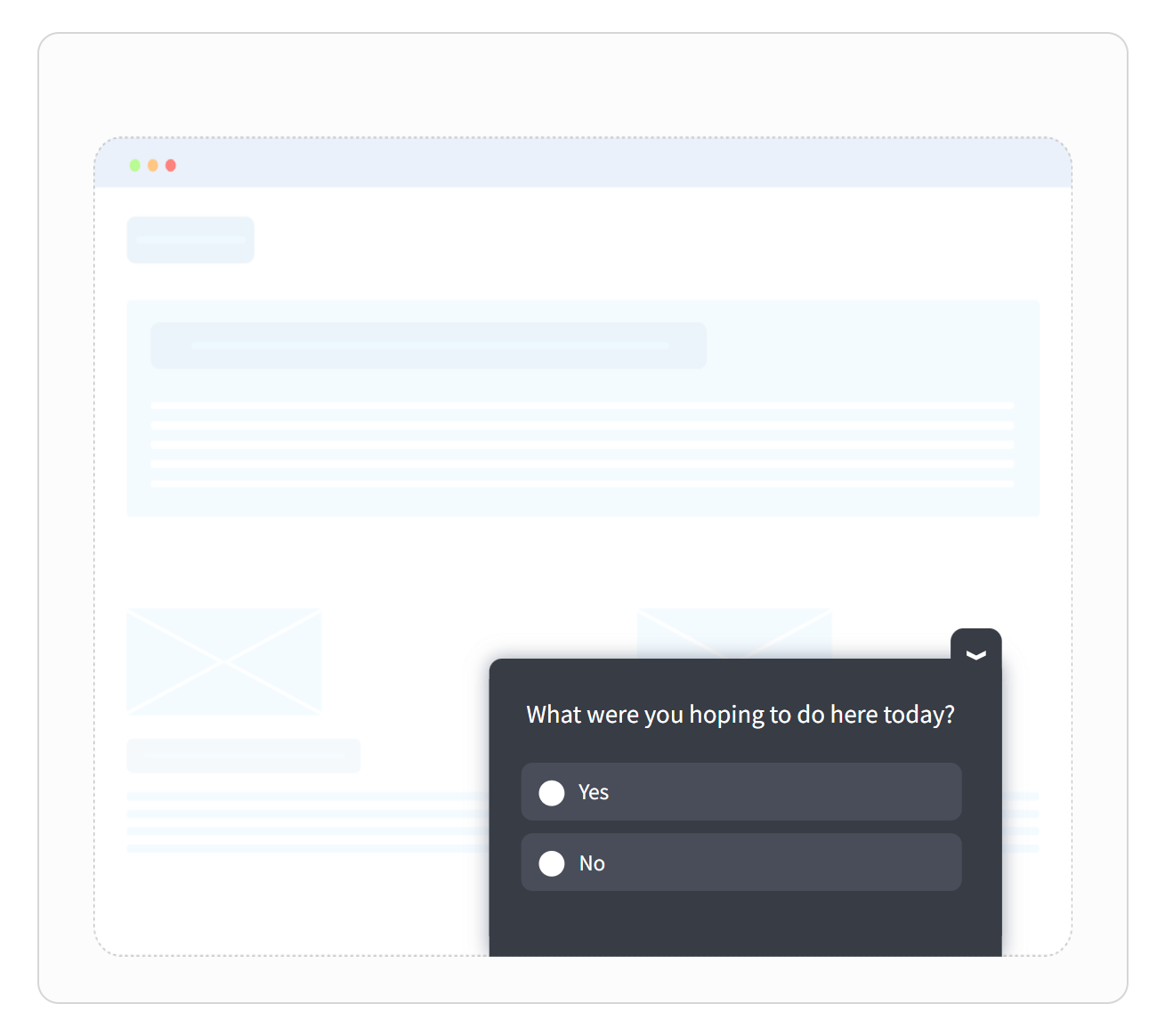
5. Close the Feedback Loop Quickly
Asking for feedback isn’t enough. Acting on it—fast—is what builds trust. Over 50% of users believe companies ignore their feedback. When that happens, their silence turns into churn.
Here’s how to close the loop:
- Tag feedback by urgency and topic using tools like Qualaroo.
- Route negative feedback to your support or product teams with Slack/CRM integrations.
- Follow up within 24–48 hours if a customer expresses frustration or confusion.
- Track whether the issue was resolved—and whether the user returned.
Feedback is a signal. Speed is your differentiator.
Pro Tip: Use automated workflows. For example, pipe “detractor” NPS responses into your CRM, assign them to a rep, and set a 48-hour resolution goal.
If a customer cancels, send a follow-up email saying: “We saw your feedback. Can we fix this for you?”
A 1-minute fix can save a $1,000 customer.
6. Install Omnichannel Support & Feedback Touchpoints
If your users can’t reach you—or can’t be heard—they’ll leave. Customers today expect seamless help across live chat, email, self-service, and even social DMs. If one channel fails, they won’t wait around.
Your goal: remove friction from every feedback and support path.
Here’s what that looks like:
- Add always-visible feedback widgets (Qualaroo-style sidebars) on web, mobile, and product.
- Offer live chat and AI bots for immediate support on high-churn pages.
- Create help centers and searchable knowledge bases for self-service.
- Monitor brand mentions on social (X, Reddit, LinkedIn) and respond quickly.
- Route urgent queries to the right teams automatically.

You don’t need 24/7 agents—just fast, clear answers at the right moments.
Pro Tip: Add an in-product “Was this helpful?” prompt after new feature launches. If <80% say yes, you’ve got a churn risk. Use cancellation intent triggers (like “cancel plan” clicks) to launch a survey or live chat prompt, right before the exit.
Pro Tip: Add an in-product “Was this helpful?” prompt after new feature launches. If <80% say yes, you’ve got a churn risk. Use cancellation intent triggers (like “cancel plan” clicks) to launch a survey or live chat prompt, right before the exit.
7. Release Regular Product Updates
If your product stops evolving, your users will too, right out the door. Nothing accelerates churn like stagnation. Whether it’s bugs left unresolved or feature requests ignored, users interpret it as “This tool isn’t for me anymore.”
But product updates do more than add functionality—they send a message:
“We’re listening. We’re improving. We’re here to stay.”
How to use this to reduce churn:
- Share a visible changelog (weekly or monthly).
- Tag feature requests with user IDs and notify them when you ship.
- Celebrate user-suggested improvements publicly—especially on social.
- Track usage post-release. If adoption is low, fix onboarding—not just the code.
Pro Tip: Even small visual updates (like button placement or mobile polish) can reactivate disengaged users. Announce them clearly. Use Qualaroo to collect real-time input on new features—right inside the feature flow. Ask: “Is this what you expected?”
8. Run Pricing Analysis & Realign Value
Many users don’t churn because your product is bad. They churn because it no longer feels worth the price. That’s a value-perception problem—and pricing is often the trigger.
Here’s how to approach it:
- Survey users before and after pricing changes to gauge perceived value.
- Identify which segments are most price-sensitive (startups, agencies, SMBs).
- Bundle underutilized but high-value features to increase plan stickiness.
- Test prepaid, annual, and freemium options to find the sweet spot for your ICP.
- Price isn’t just a number—it’s a signal of who your product is for.
Pro Tip: If you’re losing trial users, try offering a timed discount on the upgrade screen. Conversion lift often outweighs the short-term revenue drop.
Use Qualaroo to ask price-resistance questions like: “Was anything holding you back today?” or “Did the pricing feel fair?”
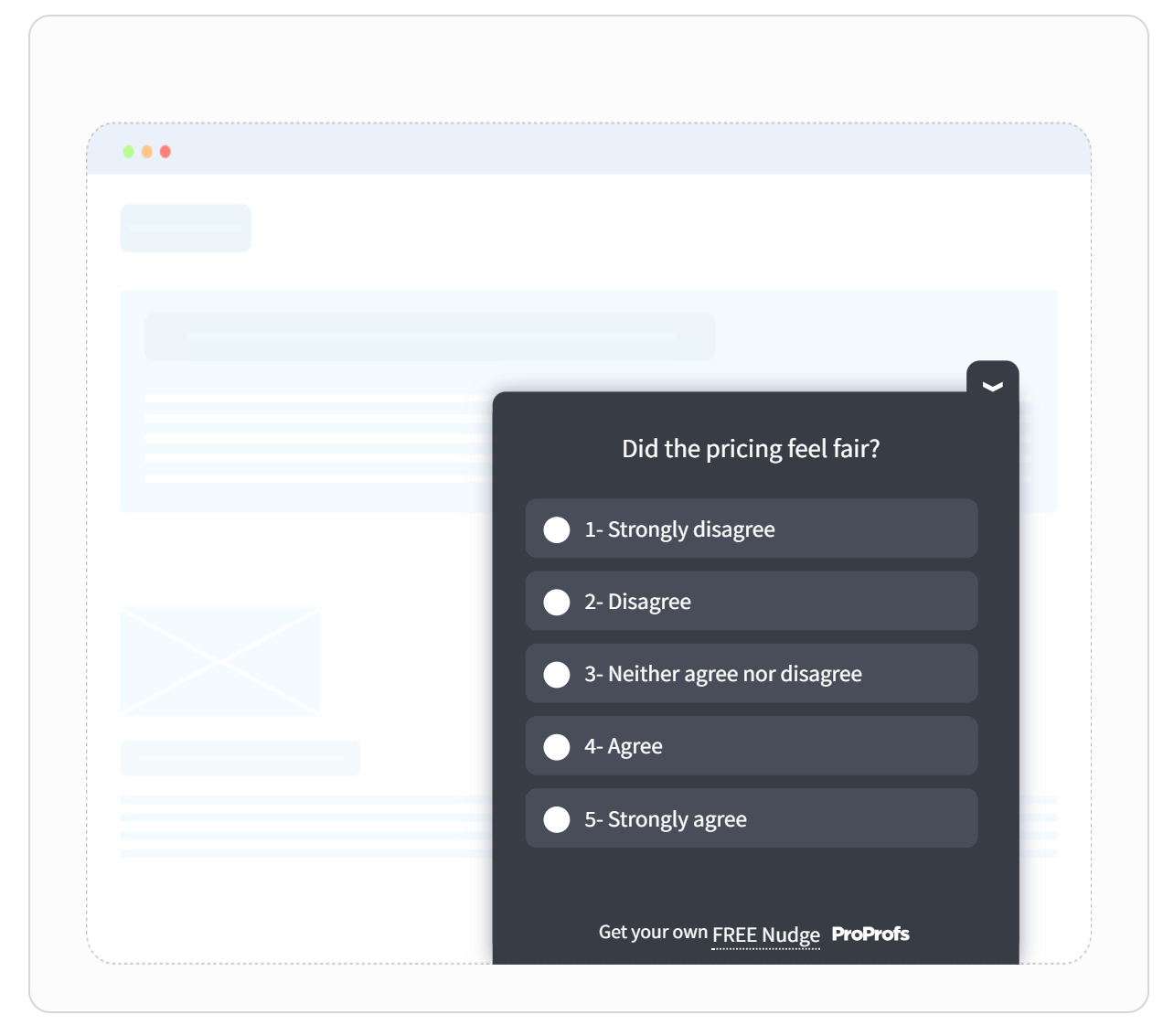
9. Segment Customers by Lifetime Value (LTV)
Not all churn is equal. Losing a $1,000 customer hurts more than losing a $10 one.
That’s why LTV-based segmentation is essential. It helps you focus retention efforts where they matter most.
How to apply:
- Group customers into tiers (e.g., high, mid, low value).
- Prioritize retention workflows (follow-ups, concierge support) for high-LTV tiers.
- For low-LTV churn, analyze whether reacquisition cost is even worth it.
Pro Tip: Use your CRM or analytics tool to create “Churn Watchlists” for high-LTV but low-activity users.
Use Qualaroo to ask high-value users: “What would make you stay longer with us?”
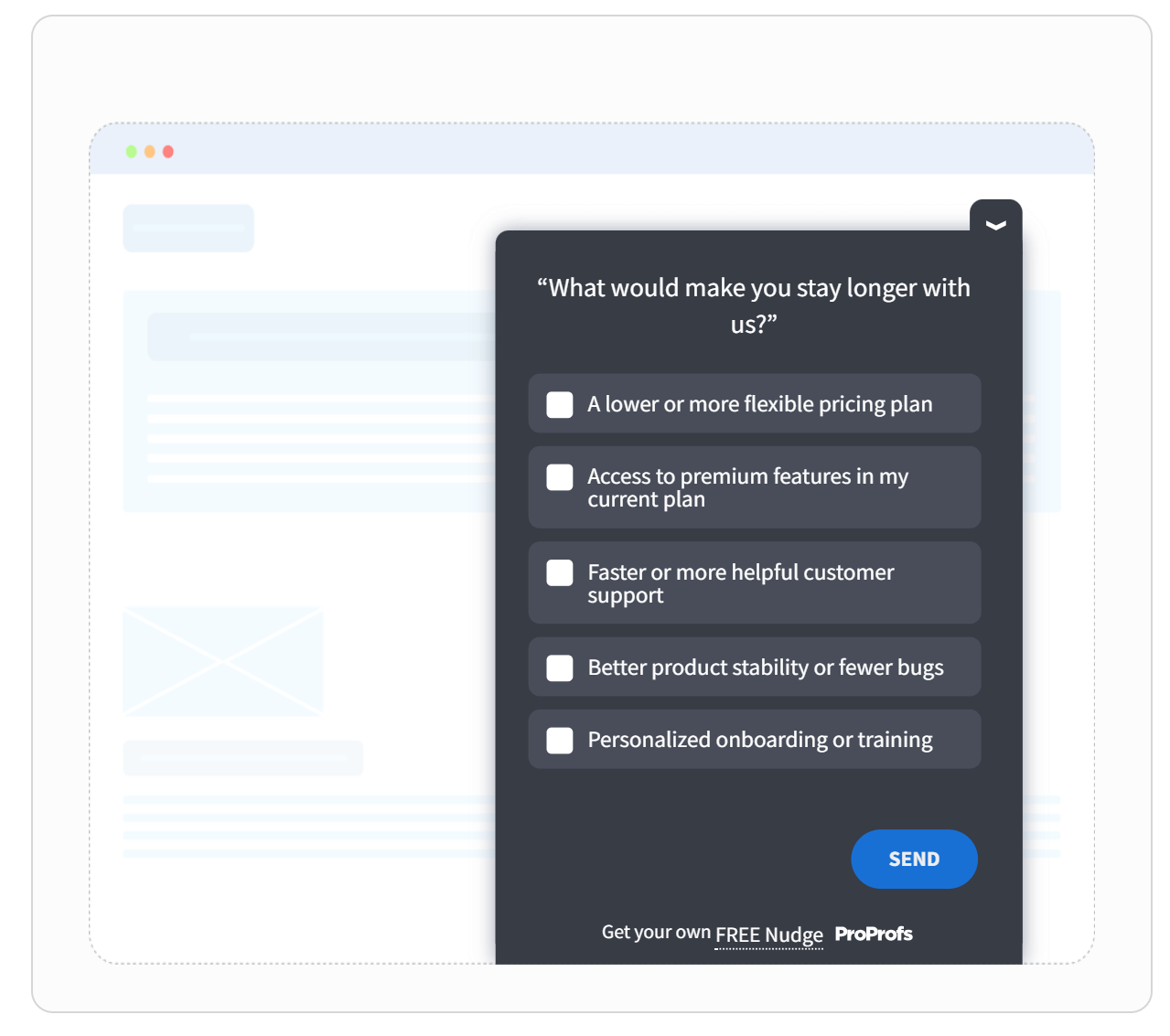
10. Run Incentivized Retention Campaigns
Incentives can reignite cold users—when they’re smartly timed. But don’t just throw out random discounts. Personalize your offers based on user behavior or loyalty.
Effective tactics:
- Offer temporary upgrade discounts to inactive freemium users.
- Send “We miss you” emails with a time-limited bonus.
- Remind users of expiring loyalty points or unused features.
Tie offers to action. For example: “Upgrade today and we’ll migrate your data for free.”
Pro Tip: Track which incentive types reduce churn vs. just delay it. Aim for habit formation, not just reactivation.
11. Nail the Onboarding Experience
Most churn happens in the first 7–14 days. That’s when users decide if your product is worth the effort. Smooth onboarding = higher stickiness.
Best practices:
- Guide users to their “aha moment” fast.
- Use checklists, in-app tours, and contextual help.
- Offer onboarding assistance for complex tools (even a 15-min call works wonders).
Use Qualaroo to ask: “Was anything unclear during setup?” right after onboarding.
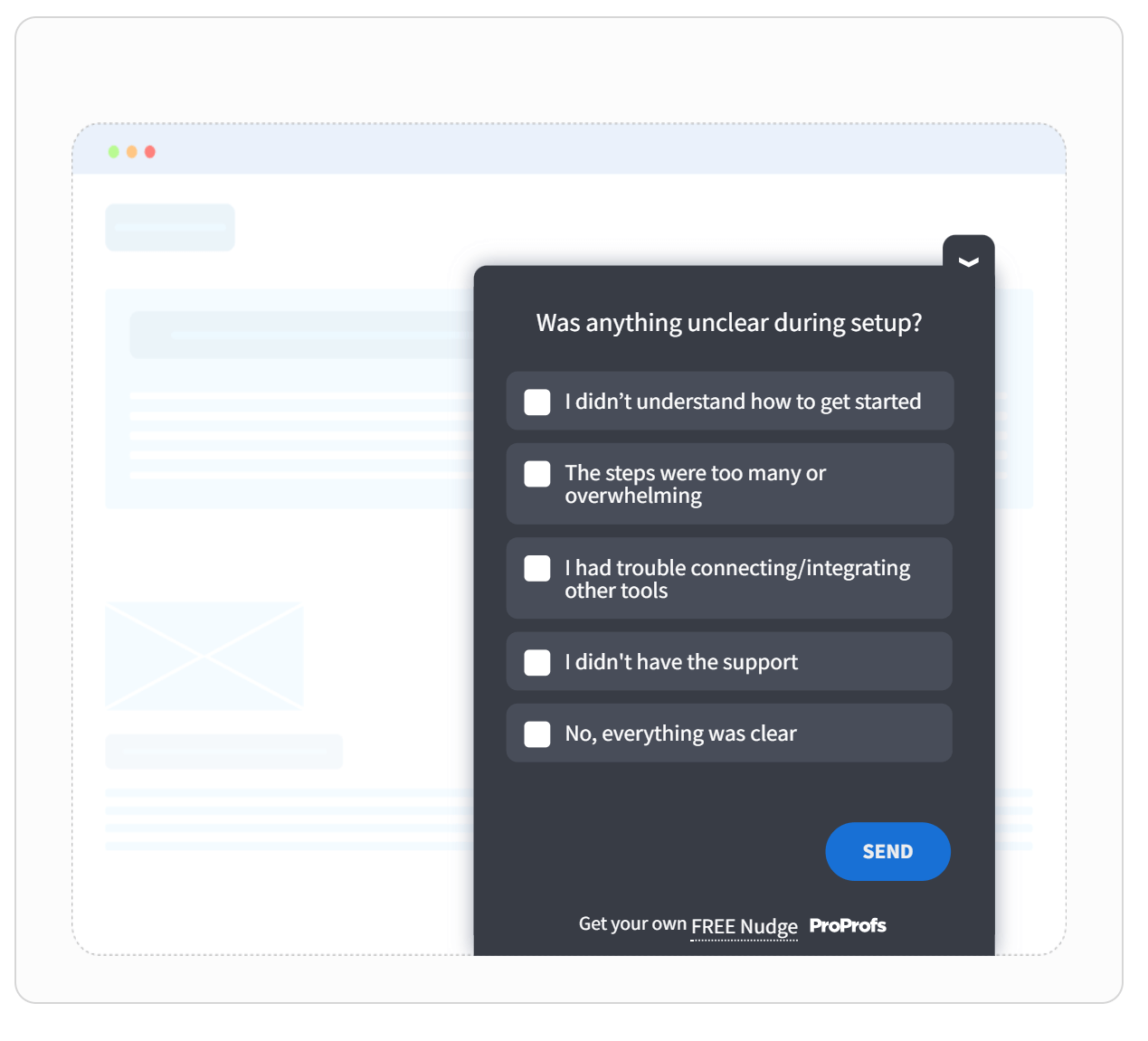
Pro Tip: If the answer is anything negative, trigger a short follow-up like:
“Thanks for sharing. What could we have done better?”
This simple nudge often yields actionable UI/UX fixes.
12. Improve Customer Communication
Unclear, inconsistent communication = churn magnet. If your customers don’t know what’s coming, what changed, or what to expect, they’re less likely to stay engaged.
Tactics that work:
- Set expectations early (especially on feature availability and pricing).
- Use email cadences to update, educate, and celebrate user wins.
- Centralize notes and past conversations in your CRM like BIGContacts to avoid context gaps.
Pro Tip: Build a monthly “customer health check” email survey that combines usage insights + tips tailored to their plan. Add feedback prompts to your help docs: “Did this solve your problem?” If not, you’ve got a churn point.
How to Build a Predictive Churn Model (Step-by-Step)
Most teams react to churn. Few predict it early enough to prevent it. This section walks you through building a simple, reliable churn prediction model—no machine learning needed.
Step 1: Define What Churn Means for You
Churn isn’t one-size-fits-all. Define it based on your product and user journey:
- SaaS: subscription cancellation, downgrade, or extended inactivity
- E-commerce: no purchase within a specific timeframe (e.g., 30 or 60 days)
- HR/Internal: employee resignation, or signs of disengagement like skipping 1:1s or missing KPIs
Start by reviewing historical churn patterns and asking: What did these users stop doing before they left?
Step 2: Identify Risk Signals
Choose behavioral and experience signals that indicate declining engagement or satisfaction.
| Signal | Interpretation |
|---|---|
| Days since last login | Higher value may mean disengagement |
| Feature usage drop-off | Declining value perception |
| No survey response | Low engagement or apathy |
| Negative NPS/CSAT score | Dissatisfaction or friction |
| Frequent support tickets | Unresolved problems |
| Failed payment attempt | Possible involuntary churn trigger |
These can come from tools like Google Analytics, CRMs, product logs, or feedback tools like Qualaroo.
Step 3: Assign Scores and Weightage
Build a churn risk score using a weighted points system. For example:
- NPS score 0–6 → +3
- No login in 30+ days → +2
- Feature use <10% of norm → +2
- Payment failure → +1
- Negative CSAT → +1
Calculate each customer’s cumulative score using Google Sheets. Set a threshold (e.g., 5+) to flag high churn risk.
Step 4: Prioritize and Visualize
Sort customers by:
- Churn risk score
- Customer value (LTV or plan tier)
- Engagement trends (e.g., declining vs. stable)
This gives you a list of high-value, high-risk customers to take action on now.
Step 5: Take Targeted Action
Once identified, don’t just observe. Intervene:
- Reach out with support offers, onboarding help, or discounts
- Trigger automated retention campaigns via email or in-app messages
- Ask for feedback on what’s not working
- Assign reps or success managers to top risk accounts
Your churn model is only valuable if it drives action. Use it to test hypotheses, close feedback loops, and improve retention strategies.
Why Retention Beats Acquisition Every Time
It’s tempting to chase new users, launch growth campaigns, and celebrate acquisition wins. But without a solid retention engine, your growth is a leaky bucket.
Here’s why focusing on retention, especially in competitive markets, delivers better long-term returns:
1. Acquisition Is Expensive. Retention Is Profitable.
Studies show that acquiring a new customer is 5–7x more expensive than retaining an existing one. That gap keeps widening with rising ad costs, shrinking attention spans, and saturated markets.
If your CAC (Customer Acquisition Cost) is climbing and churn remains high, your LTV:CAC ratio will break, and growth will stall.
Bonus: Always ask: Have we earned back the cost of acquiring this user before they churned?
2. Retained Customers Spend More Over Time
Longer-tenured customers typically:
- Spend more per transaction
- Are more open to upsells or cross-sells
- Have lower support and onboarding costs
- Refer more often, bringing in higher-quality leads
These are the users whose workflows your product supports most deeply. Keep them happy, and they’ll help define your roadmap—and market it for you.
3. Retention Fuels Predictable Growth
When churn is under control, you can project revenue and invest confidently in growth. That means:
- Smarter hiring
- More accurate forecasting
- Better capital efficiency
- Healthier Monthly Recurring Revenue or Annual Recurring Revenue trends
Compare that to a team constantly plugging churn holes—there’s no room to scale if the foundation isn’t stable.
4. Loyal Customers Are Your Competitive Moat
In industries where switching is easy (SaaS, DTC, fintech), loyalty is a differentiator. When a customer sticks with you through ups and downs, it’s often because they:
- Feel heard (your feedback loops work)
- Trust your support (you’ve resolved issues fast)
- See continuous value (you’ve evolved with them)
And that’s not built through better ads. It’s built through consistent retention work.
Case Study: How Belron Reduced Churn With Real-Time Feedback Loops

Belron, a global leader in vehicle glass repair, faced a challenge: they were losing high-value customers without knowing why.
Instead of relying on quarterly feedback or lagging support metrics, the team implemented real-time surveys via Qualaroo at key customer touchpoints—right after service completion.
They then used AI-based sentiment analysis to identify negative experiences instantly. Every detractor’s comment was routed to the relevant team (technicians, support, ops) within hours.
The results?
- NPS increased by 20 points in 6 months.
- Churn among high-value customers dropped by 18%.
- Frontline staff used insights from open-ended feedback to improve first-time resolutions.
Key takeaway: Don’t wait for churn to show up in dashboards. Catch it at the moment of experience—and act immediately.
FREE. All Features. FOREVER!
Try our Forever FREE account with all premium features!
Focus More on Customer Retention Than Acquisition
With customers switching brands right and left, retention strategies are a solid foundation for growth. If people constantly leave your business, you cannot build a loyal customer base to produce recurring revenue.
Fortunately, small steps can help retain customers, and one of them is providing an engaging seamless experience and reducing churn rate.
Start by listening to them to find the gaps in the customer journey. These include the interaction points where customers face issues or express grievances. For example, you can use a feedback tool like Qualaroo to deploy surveys whenever a customer contacts you via the helpdesk ticket. It will also help you to explore any previously unknown critical customer touchpoints.
Combine this with impeccable offline and online customer service; you already provide an optimized experience.
Now, you can move towards fine-tuning engagement using offers, programs, and other strategies mentioned in the blog to combat customer churn. Remember, it’s an iterative process. So gather data from your efforts and use it to refine the process in the next cycle.
Frequently Asked Questions
What does churn mean in business?
Churn indicates customers who left the company due to poor experiences. These include delays in addressing grievances, a lack of an in-depth knowledge base, product issues, pricing, etc.
What is a good churn rate?
It depends on your industry. Here are some rough benchmarks:
- SaaS (B2B) Churn Rate: 5–7% annually is considered healthy
- SaaS (B2C) Churn Rate: 3–5% monthly churn is normal
- E-commerce: 20–40% can be typical, depending on product stickiness
- Mobile apps: Can go up to 80% in the first 90 days if onboarding is poor
Don’t chase “low churn” blindly. Focus on identifying why users leave and fixing the root causes by stage (adoption, usage, drop-off).
How can I analyze why users abandon my Shopify Plus store without purchasing?
Use exit-intent surveys targeted at cart and checkout pages. Ask questions like:
- “What stopped you from completing your purchase today?”
- “Was anything missing from your cart or checkout?”
Tools like Qualaroo let you trigger these surveys only when users show signs of exit (e.g., moving the cursor toward the tab close button). Combine this feedback with behavioral data, such as time on page or cart abandonment rate, to identify friction points.
What’s the best way to reduce form abandonment for lead gen or job applications?
Embed micro-surveys at the point of drop-off. Trigger them after 20–30 seconds of inactivity or partial completion.
Ask:
- “What prevented you from submitting this form?”
- “Was there a question that felt unclear or too personal?”
Use answers to streamline the form and build trust—two key drivers of conversion here.
FREE. All Features. FOREVER!
Try our Forever FREE account with all premium features!

 We'd love your feedback!
We'd love your feedback! Thanks for your feedback!
Thanks for your feedback!

